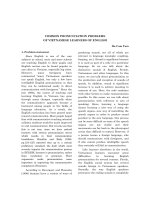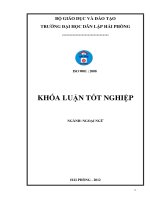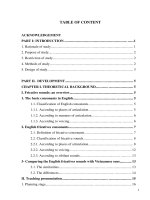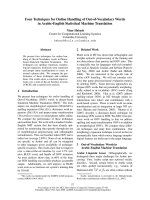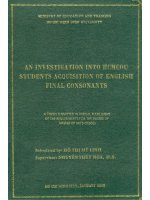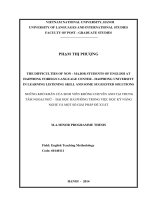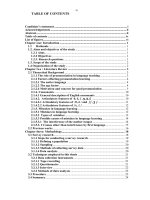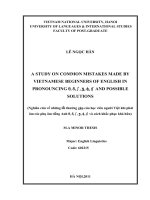problems of hatinh learners in pronouncing english final consonants = khó khăn của học viên hà tĩnh trong việc phát âm phụ âm cuối tiếng anh
Bạn đang xem bản rút gọn của tài liệu. Xem và tải ngay bản đầy đủ của tài liệu tại đây (577.28 KB, 39 trang )
1
VIETNAM NATIONAL UNIVERSITY, HANOI
UNIVERSITY OF LANGUAGES AND INTERNATIONAL STUDIES
FACULTY OF POST- GRADUATE STUDIES
PHẠM THỊ TÚ HẰNG
PROBLEMS OF HATINH LEARNERS IN
PRONOUNCING ENGLISH FINAL CONSONANTS
(Khó khăn của học viên Hà Tĩnh trong việc phát âm phụ âm
cuối Tiếng Anh)
M.A. MINOR PROGRAMME THESIS
Field: English Linguistics
Code: 60.22.15
HANOI- 2010
VIETNAM NATIONAL UNIVERSITY, HANOI
2
UNIVERSITY OF LANGUAGES AND INTERNATIONAL STUDIES
FACULTY OF POST- GRADUATE STUDIES
PHẠM THỊ TÚ HẰNG
PROBLEMS OF HATINH LEARNERS IN
PRONOUNCING ENGLISH FINAL CONSONANTS
(Khó khăn của học viên Hà Tĩnh trong việc phát âm phụ âm
cuối Tiếng Anh)
M.A. MINOR PROGRAMME THESIS
Field: English Linguistics
Code: 60.22.15
Supervisor: Hà Cẩm Tâm Ph.D.
HANOI- 2010
DECLARATION
6
TABLE OF CONTENTS
DECLARATION i
ACKNOWLEDGEMENTS ii
ABSTRACT iii
TABLE OF CONTENTS iv
LIST OF TABLES AND ABBREVIATIONS v
PART ONE: INTRODUCTION 7
1. Rationale of the study 8
2. The aim of the study 8
3. Hypothesis 8
4. The scope of the study 8
5. Research method 9
6. Organization of the study 9
PART TWO: DEVELOPMENT 9
Chapter 1: LITERATURE REVIEW 9
1.1 Phonetics 10
1.2 Phonology 10
1.3 Articulatory phonetics 11
1.4 Consonants 13
1.4.1 General description of consonants. 13
1.4.1. Classification of consonants. 14
1.4.3 English consonants 16
1.4.4 Vietnamese Consonants 19
1.4.5 English vs. Vietnamese 20
1.5 Review of previous research 21
Chapter 2: THE STUDY 23
2.1 Research questions 24
2.2 Data collection instruments 24
2.3 Data collection procedures 24
2.4 The subjects 25
2.5 Analytical framework 25
2.5.1 Plosive or stop /p, t/ 25
2.5.2 Affricate /tʃ/ 26
2.5.3 Fricative /ð, s/ 26
2.6 Data analysis 27
2.6.1 /ð/ sound 28
2.6.2 /p/ consonant 29
2.6.3 /tʃ/ consonant 29
2.6.4 /t/ consonant 30
2.6.5 /s/ consonant 30
2.7 Discussion and findings 33
PART THREE: CONCLUSION 36
1. Conclusions 36
2. Implications 37
3. Limitations and suggestions for further study 38
REFERENCES 39
7
LIST OF TABLES
Table 1: Consonants of English
Table 2: Number of subject mispronounced the consonants under study
Table 3: Sounds deviations of the consonants under study made by the informants
Table 4: Sound omission made by informants
ABBREVIATIONS
HTU: Hatinh University
RP: Received Pronunciation
L1: Mother tongue
L2: Second Language
PART ONE: INTRODUCTION
8
1. Rationale of the study
English has become one of the most popular languages in the world. It is a main tool
for global communication. Therefore, correct pronunciation plays a very important part in
using spoken English. Mispronunciation may lead to misunderstanding and the process of the
communication may even be broken down. “A learner who consistently mispronounces a
range of phonemes can be extremely difficult for a speaker from another language
community to understand” (Kelly, 2000:11). There is a fact that a lot of Vietnamese learners
often mispronounce English words, especially word-final consonants. As a result, they
produce incomprehensible utterances. Hatinh learners are not the exception even though they
have learnt English since the early age. Another reason is that no research has been carried
on this field at Hatinh University (HTU). This leads the author to the thought of making a
research on “Problems of Hatinh learners in pronouncing English final consonants” with the
purpose of finding out the causes of mispronunciations.
2. The aim of the study
The study aims at finding out if HTU learners have difficulties in pronouncing English word
final consonants and what the causes of these problems are. The results will provide an
overview of learners‟ pronunciation at HTU and give suggestions for teachers to improve the
situation. The findings of this research will hopefully help HTU students to raise their
awareness of learning correct pronunciation so as to produce English word-final consonants
properly.
3. Hypothesis
1. HTU learners have difficulties in pronouncing English word-final consonants.
2. Their problems may be caused by mother tongue interference.
4. The scope of the study
This research presents several analyses on the pronunciation of the five consonants
occurring in some selected words using for recording namely /s/, /tʃ/, /ð/, /t/, /p/ in final
position made by the ten English majored students studying at HTU with a hypothesis that
9
these consonants are pronounced in Vietnamese-like way. Basing on the findings, problems
in pronouncing these sounds and the causes of them will be pointed out with solutions.
5. Research method
In the study, the author intends to figure out if HTU students have difficulties in
pronouncing some English word final consonants and how different their pronunciation of
these sounds is in comparison with that described in the analytical framework basing on
Received Pronunciation (RP) standard. A combination of different data collection methods
was used including recording the participants‟ pronunciation of prepared words and
observing their spoken English in class. Details of methodology applied in the study are
discussed in Chapter 2 of Part two.
6. Organization of the study
The study composes of three parts:
Part one, Introduction, includes the rationale, aims, research question, scope, method
and organization of the study.
Part two, Development, consists of two chapters. Chapter one, Literature Review,
presents the theoretical background relevant to the research. The first section describes the
basic concepts of phonetics, phonology and articulatory phonetics. The second section offers
a theoretical presentation of consonants, English consonants and the consonants under study.
The last section summarizes the review of previous research related to consonant
pronunciation. Chapter two, the Study, describes the context of the study, the participants, the
method, the findings and discussion.
Part three, Conclusion, summarizes the findings and gives suggestions for improving
English final pronunciation for HTU students.
PART TWO: DEVELOPMENT
Chapter 1: LITERATURE REVIEW
10
This chapter is devoted to the presentation of the theoretical issues related to the study.
The first section provides some basic linguistic and phonetic concepts to bring a common
view of the matter studied including phonetics, phonology, and articulatory phonetics. The
second section describes consonants in general, English and Vietnamese consonants. The
final section discusses the review of some previous research related to consonant
pronunciation
1.1 Phonetics
Phonetics is the study of human speech sounds. It is concerned with various aspects relevant
for the physical characteristics of sounds. Several branches of phonetics can further be
distinguished, depending on the narrower domain of interest of the respective field. There are
three main areas of phonetics: articulatory phonetics, acoustic phonetics and auditory
phonetics, (Jack C.R. et al, 1997).
Articulatory phonetics deals with the way in which speech sounds are produced. Sound
are usually classified according to the position of lips and the tongue, how far open the
mouth is, whether or not the vocal cords are vibrating and so on.
Acoustic phonetics deals with the transmission of speech sounds through the air. When
a speech sound is produced it causes minor air disturbances (sound waves). Various
instruments are used to measure the characteristics of these sound waves.
Auditory phonetics deals with how speech sounds are perceived by the listener,
1.2 Phonology
Phonology is essentially the description of the systems and patterns of speech sounds
in a language, (Ladefoged, 2001:23). It involves studying a language to determine its
distinctive sounds and to find out which sounds convey a difference in meaning. When two
sounds can be used to differentiate words, they are said to belong to different phonemes.
There must be a phonemic difference if two words (such as “white” and “right” or “cat” and
“bat”) differ in only a single sound.
"Phonology deals with the speakers‟ knowledge of the sound system of a language. It is
therefore exclusively concerned with langue or competence [ ] Phonology can be divided
11
into two branches: (1) segmental phonology and (2) suprasegmental phonology" (Skandera
& Burleigh, 2005:5)
Phonology is primarily concerned with how we interpret and systematize sounds. It
deals with the system and pattern of the sounds which exists within particular languages. The
study of phonology of English looks at the vowels, consonants and superasemental features
of the language. Within the disciplines of phonology, when we talk about vowels and
consonants we are referring to the different sounds we make when speaking, and not the
vowel and consonants letters we refer to when talking about spelling.
When we describe the sound patterns that occur in English, we want to be able to say
that in some sense there are always the same underlying sounds may change depending on
the context in which they occur. The phonology of a language is the set of rules that describe
the changes in the underlying sounds, the abstract units called phonemes. When we
transcribe a word in a way that shows none of the details of the pronunciation that are
predictable by phonological rules, we are making a phonemic transcription, (Ladefoged,
2001). The variants of the phonemes that occur in details phonetic transcriptions are known
as allophones. They are generated as a result of applying the phonological rule to the
underlying phonemes.
This research aims at finding out if HTU students have difficulties in pronouncing the
five chosen English consonants in the final position. It takes the problems of their
pronunciation into consideration which concerns with the way they use their organs of
articulation pronouncing such sounds. This is also what articulatory phonetics study, so the
theoretical background of it is presented with more details as follows.
1.3 Articulatory phonetics
Articulatory phonetics, one of three main branches of phonetics, is the study of the
organs of speech and their use in producing speech sounds. The term 'organs of speech' refers
to those parts of the human body that are concerned in various ways with the production of
speech. A lot of them are only secondarily concerned with the production of speech- their
primary functions have to do with eating, chewing, and swallowing food, and respiration.
Those parts of the body below (not the lungs) belong to the vocal tract. The vocal tract is
12
divided into the supraglottal and the subglottal tract (as shown in Picture1),(Ladefoged,
2001).
In nearly all speech sounds, the basic source of power is the respiratory system pushing
air of the lungs. Air from the lungs goes up the windpipe and into the larynx at which point it
must pass between two small muscular folds called the vocal folds. If the folds are apart, as
they normal are when breathing out, the air from the lungs will have a relatively free passage
into the pharynx and the mouth. But the vocal folds are adjusted so that there is only a
narrow passage between them, the airstream will cause them to vibrate. Sounds produced
when the vocal folds are vibrating are said to be voiced , as opposed to those in which the
vocal folds are apart, which are said to be voiceless. The air passages above the larynx are
known as the vocal tract. The shape of the vocal tract is very important factor in the
production of speech.
The parts of the vocal tract that can be used to form sounds are called articulators. The
articulators that form the lower surface of the vocal tract often move towards those that form
the upper surface.
The names of principal parts of upper surface of the vocal tract are the upper lip, upper
teeth, alveolar ridge, hard palate and soft palate or velum. The soft palate is a muscular flap
that can be raised to press against the back wall of the pharynx and shut off the nasal tract,
preventing air from going out through the nose. At the lower end of the soft palate is a small
appendage hanging down that is known as the uvula. The part between the uvula and the
larynx is the pharynx.
The lower lip and the specific names for different parts of the tongue form the lower
surface of the vocal tract. The tip and the blade of the tongue are the most mobile parts.
Behind the blade is what technically called the front of the tongue: it is actually the forward
part of the body of the tongue, and it lies underneath the hard palate when the tongue is at
rest. The remainder of the body of the tongue may be divided into the center which is partly
beneath the hard palate and partly beneath the soft palate; the back, which is beneath the soft
palate; and the root, which is opposite the back wall of the pharynx.
13
Picture 1: The organs of speech
Articulatory phonetics deals with the major aspects of speech production. They are the
air stream mechanism, the state of vocal cords, the state of velum, the place and the manner
of articulation, ( Davenport & Hannahs, 1998). On the other hand, this study is paid
attention to consonants, particularly the five studied consonants; therefore, the manner, the
place of articulation and voicing- the three main features of consonants are discussed with
more interest later.
1.4 Consonants
1.4.1 General description of consonants.
A consonant is a speech sound where the air stream from the lungs is completely
blocked (STOP), partially blocked (LATERAL) or where the opening is so narrow that the
air escapes with audible fiction (FRICATIVE). With some consonants (NASALS) the air
stream is blocked in the mouth but allowed to escape through the nose. (Richard et al, 1997)
A consonant is a speech sound that functions at the margins of syllables, produced
when the vocal tract is either blocked or so restricted that there is audible friction. (Crystal,
2003)
From a phonetic point of view, they are articulated in one of two ways: either there is a
closing movement of one of the vocal organs, forming such a narrow constriction that it is
possible to hear the sound of the air passing through; or the closing movement is complete,
giving a total blockage. The closing movement may involve the lips, the tongue, or the
throat. But in each case the overall effect is very different from the relatively open and
14
unimpeded articulation found in vowels. In articulatory phonetics, a consonant is a sound in
spoken language that is charactized by closure or stricture of the vocal tract sufficient to
cause audible turbulence, (Crystal, 2003:242).
Consonants, actually, are sounds made with closed or nearly closed articulations. As a
consequence, they tend to break up the stream up speech, defining a perceptual and
articulatory edge, or margin, for a unit (word or syllable in a word) that includes one or more
vowels.
1.4.1. Classification of consonants.
Consonants are formed by interrupting, restricting or diverting the airflow in a variety
of ways. They can be divided into different kinds in accordance with three categories, i.e. the
degree of vocal cord vibration, the place and the manner of articulation. Some consonants
involve the vibration of the vocal cords: these are the voiced consonants. Others have no
vocal cord vibration: these are the voiceless consonants. However, the distinction is not
absolute: depending on where in a word consonant appears, there may be degrees of
voicing,( Kelly, 2000 : 5-7).
1.4.1.1 The manner of articulation.
The manner of articulation refers to the interaction between the various articulators act
in such way that the air is temporarily trapped, and then suddenly released. Consonants
classified based on the manners of articulation are plosive, affricate, fricative, nasal, lateral,
approximant, (Kelly, 2000).
Plosive
a complete closure is made somewhere in the vocal tract, and
the soft palate is also raised. Air pressure increases behind the
closure, and is then released „explosively‟.
Affricate
a complete closure is made somewhere in the mouth, and the
soft palate is raised. Air pressure increases behind the closure,
and is then released more slowly than in plosives.
Fricative
when two vocal organs come close enough together for the
movement of air between them to be heard.
Nasal
a closure is made by the lips, or by the tongue against the palate,
15
the soft palate is lowered, and air escapes through the nose.
Lateral
a partial closure is made by the blade of the tongue against the
alveolar ridge. Air is able to flow around the sides of the tongue,
ApproximantVocal organs come near to each other, but not so close as to cause
audible friction.
1.4.1.2 The place of articulation.
The place of articulation focuses more on what the various articulators actually do. The
place of articulation defines both the area of the oral-pharyngeal vocal tract where the
constriction is made and the part of the tongue used to form the constriction. The sounds of
this classification include bilabial, labio-dental, dental, alveolar palato-alveolar, palatal,
velar and glottal, (Kelly, 2000).
With regards to the place of articulation, the following table summarizes the main
movements of the various articulators:
Bilabial
Using closing movement of both lips.
Labio-dental
Using the lower lip and the upper teeth.
Dental
The tongue tip is used either between the teeth or close to the upper
teeth.
Alveolar
The blade of the tongue is used close to the alveolar ridge.
Palato-
alveolar
The blade (or tip) of the tongue is used just behind the alveolar
ridge.
Palatal
The front of the tongue is raised close to the palate.
Velar
The back of the tongue is against the soft palate.
Glottal
The gap between the vocal cords is used to make audible friction,
1.4.1.3 The degree of vocal cord vibration
Voicing is also one the main categories that consonants have to base on when being
described. The vocal folds may be held against each other at just the right tension so that the
air flowing past them from the lungs will cause them to vibrate against each other. This
process is called voicing. Sounds that are made with vocal fold vibration are said to be
voiced.
16
Sounds made without vocal fold vibration are said to be voiceless. There are several
pairs of sounds in English which differ only in voicing that is, the two sounds have identical
places and manners of articulation, but one has vocal fold vibration and the other doesn't, for
example, /s, z/ or /θ, ð/
Describing the force of articulation, the terms fortis or strong and lenis or weak are
often used. In spoken English, fortis happens to equate with unvoiced sounds, which require
a more forcefully expelled airstreams than lenis sounds which in English happen to be
voiced. As far as English consonants are concerned, the distinction is most useful when it
comes to distinguishing between sounds that are articulated in essentially the same way, one
using the voice, the other not. An example pair is /p/ (unvoiced, and fortis), and /b/ (voiced,
and lenis), (Kelly, 2000)
1.4.3 English consonants
Most dialects of English have about 24 distinctive (phonemic) consonant sounds divided
according to three different categories: voicing, place and manner of articulation, as shown in
the table 1 with the rows for places of articulation and the columns for manners of
articulation. (Kelly, 2000)
1.4.2.1 Classification of English consonants
A stop cuts off airflow through either the mouth or the nose so there are oral and nasal
stops. Oral stops are often called plosives: [p, b], [t, d], [k, g]. Nasal stops are usually called
nasals: [m], [n] and [l]. English fricatives include [f, v], [θ ð], [s, z], [ʃ, ʒ] and [h] English
approximants are [j], [w], [.1], and [I]. Affricates can be seen as a sequence of a stop and a
fricative which have the same or similar place of articulation, and there are only two
affricative sounds in English [ tʃ ] [dʒ], (Wikipedia, the free encyclopedia). The summary of
English consonants is shown in Table 1 below:
Place of articulation
Front back

